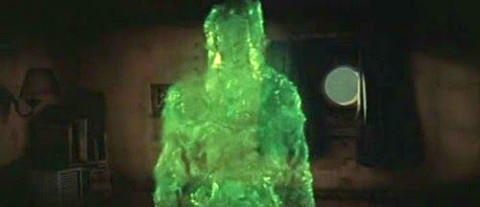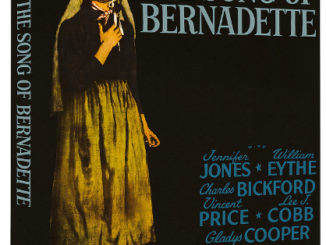The H-Man (1958)
Directed by: Ishirô Honda
Written by: Hideo Kaijo, Takeshi Kimura
Starring: Akihiko Hirata, Kenji Sahara, Koreya Senda, Yumi Shirakawa
AKA BIJO TO EKITAININGEN, THE BEAUTY AND THE LIQUID PEOPLE
JAPAN
AVAILABLE ON BLU-RAY: 16TH NOVEMBER, from EUREKA ENTERTAINMENT in the ISHIRO HONDA DOUBLE FEATURE boxset
RUNNING TIME: 87 min/ 79 min [US version]
REVIEWED BY: Dr Lenera, Official HCF Critic
In the outskirts of Tokyo, a drug smuggler named Misaki is mysteriously killed while trying to get away from a botched deal, leaving only his clothes behind. The police visit his apartment, only to find his girlfriend, cabaret singer Chikako Aria, who says he hasn’t returned for five days. They stake out the nightclub where she works and find a man in her room who turns out to be Masada, a professor who has a strange theory about Misaki’s death. When a gangster threatening Arai dies in the same manner as Misaki, Masada takes her and the police to a hospital where there are two survivors of a six-crew ship who, several months ago, came across the ryujim maru 2, a ship which supposedly disappeared during a nuclear experiment, and encountered deadly creatures on board….
If Blu-ray had existed twenty years ago, perhaps even ten years ago, it’s doubtful that the name Ishiro Honda would be linked with the term ‘masters of cinema’. However, things have sure moved on, and even if a few snobby film lovers may still scoff, I entirely agree with one of our favourite boutique labels releasing three of his films in their Masters of Cinema series. Honda, best known for many of the Godzilla movies especially the original classic, was a fine filmmaker of the fantastique, producing colourful, imaginative, exciting and sometimes even dreamlike entertainments which were also usually able to often to squeeze in messages that were important to Honda, such as the need for world peace and the protection of the environment. Eureka are bringing out the three Honda pictures that were released theatrically by Columbia Pictures in the US during a time when imported Japanese science fiction was good business, even if critical reaction was often dismissive and even borderline racist. The first of these is The H-Man, perhaps the least of the films but still one that’s of considerable interest. It’s a rather offbeat combination of film noir and science-fiction horror along the lines of The Blob, though made before it. Though it seems to be remembered fondly by kids who were scared half to death by it in 1958, it’s probably Honda’s most adult picture, which, whilst still quite subtle by the standards that we’re used to today, is more frightening and gruesome than any other film to come from the man as well as being largely set in a rather sleazy and violent mileau. It’s a little awkward at times and suffers from too much footage of the police sitting around talking when they should be doing, but is still essential viewing if you think Toho was only good at large-scale destructive spectacles featuring oversized monsters and alien invaders.
Toho Studios and Honda had had a big success with 1954’s Godzilla. Motoyoshi Oda directed the follow-up Godzilla Raids Again, then Honda was brought back for Rodan and the alien invasion picture The Mysterians, becoming Toho’s prime director of special effects films even though it seems that he preferred to make more reality-based, documentary-like dramas. That film showed signs of being aimed at a younger audience, so The H-Man seems to be a deliberate reaction against that. An actor named Hideo Unagami wrote the short story on which Takeshi Kimura’s screenplay was based. An inspiration may have been the same incident which partly led to Godzilla, where sailors on a Japanese tuna fishing boat was exposed to and contaminated by nuclear fallout from a US nuclear bomb test. Though it’s perhaps hard to believe, Honda asked biologists at the University of Tokyo’s biology department for reassurance that there was a small amount of believability in the script’s pseudo-science. For the luminous green H-Men, they added water to organic glass, then inserted the glass between two bits of transparent glass, then repeatedly pulled the two bits of glass apart and back together again, resulting in a jelly-like substance, while their gooey liquid were made of a concoction made from seaweed for body lotions, chopped into bits, soaked in water overnight, then stirred each morning to the right thickness. More explanation of the somewhat vague creatures was cut from the script, as was a more upbeat reunion for its couple. It was another hit for Toho and did pretty well in the US too, shorn of eight minutes, though of course its new title The H-Man lost the poetry of its original Japanese title. Toho went on to make two other films where men transform themselves into other matter; The Human Vapour [also directed by Honda] and The Secret Of The Telegian.
Grainy real footage of a atomic bomb tests is followed by a highly atmospheric opening, set partly in pouring rain, that has a real noir feel to it. Hoodlum Misaki emerges from a sewer to meet another man waiting inside a car for a drug deal, but when he opens the boot he shoots at something that appears to melt him, seeing as all that remains of him afterwards are his bag and clothes. The police unsurprisingly find accounts from witnesses to be far-fetched, but Detective Tominaga is determined to get to the bottom of things and brings Misaki’s girlfriend Chikako in for questioning. When his boss tells him to release her with the reason,“she’s very pretty, Misako won’t leave her alone”, it’s hard to disagree. The cops then stake out the club and arrest Masada, a biologist and a university professor, as a suspect, after finding a note he wrote to Chikako, but Tominaga eventually clears him and they team up to solve this bizarre case which leads to a hospital and a terrifying story. It’s rather amusing how incompetent the police are, even when shown virtual proof of what’s going on before their very eyes. The film keeps having scenes of the cops, usually in their office, trying to work things out even after we know better, and as a result not really enough momentum is built up at a time when things should be getting more exciting. Nonetheless, we remain intrigued, even when the combination of gangsters and monsters fails to reach its full potential with a final act that’s disappointingly conventional. Despite the seeming influence of Them!, the destruction of the H-Men is rather undramatic and it almost seems like they ran out of money, though, as was often the case, Honda was able to conclude with a firm statement of the anti-nuclear theme which is quite explicit throughout this film.
When the film focuses on its title creatures [there are more than one], it really is very effective. The flashback of the sailors on the ship has a real sense of dread as the men explore the decayed vessel with their faces lit from below by their lanterns, before the H-Men attack and people start dissolving; Honda never came as close as this to pure terror, even in Godzilla. Except for one instance of animation and superimposition where the picture is actually freeze-famed which nonetheless has a surprising feeling of sexual violation about it, the slime is genuinely convincing as it crawls towards and up its victims, while the scenes of the dissolving humans are startling. They deflated human-shaped balloons in fast-motion, then ran the film again at normal speed. You even see one guy bend in half as he deflates. The liquid people look good too, quite creepy and with some attention to detail as you can make out some sort of breathing apparatus in their stomach – and I haven’t yet mentioned the dissolving frog in the laboratory, the creature seemingly melting as bubbles form on top of it, a visual that is quite disturbing -and this happens twice [well, I’ve already mentioned how slow the police are]. However, the script as filmed is vague concerning its monsters. On the ship we see dissolved victims seemingly ‘become’ H-Men, but this idea is neither explained nor employed again, while most of the time we just see the slime; and why do they seem to mostly target gangsters when on land? Oh well, we’re in Japanese monster movie land, so who really cares? A shot where we see, at night, the luminous H-Men moving around the darkened ship from a distance, is one of the most evocative and creepy bits ever in a Toho film.
Despite containing two ‘dissolving’ kills early on, The H-Man otherwise takes its time to bring in its fantasy element, instead choosing to concentrate on its police, gangsters and Chikako With scantily clad dancers writhing around in the club where the Chikako sings, the constant threat of violence and even a scene where Chikako is slapped around, and another one where she’s forced to strip, we really are in slightly more lurid territory than is normal for Honda, though he did make the violent gangster pic A Man In Red which, as with most of Honda’s non-fantasy films, seems impossible to see in the west. There’s also quite a downbeat feel enhanced by most of the action being set at night and all that rain often pouring down outside, creating a compelling atmosphere. The human side of the story is led by the dumb detective Tominaga’s rivalry with Misaki which eventually blossoms into grudging respect. Kenji Sahara and Akihiko Hirata were the two most prominent stars of these films at this time, and seem to be enjoying themselves playing off each other while also getting in to their respective roles very well. Chikako is interesting and a bit of a mystery. She partly fills the role of a femme fatale and is certainly at the centre of things as much as the H-Men, though it seems that it’s certainly not her fault that she’s mixed up with crooks, nor that she seems to draw men to her like moths to a flame; in fact Yumi Shirakawa plays her as something of an innocent surrounded by men who all want things from her, even the cops. She looks fabulous when singing [albeit with a voice which is nothing like her own and sounds too American] 40’s style ballads as she slinks around the club in stunning dresses which subtly enhance some of her features, though we don’t get much sense that she’s upset over Misaki’s death, and a scene or two between her and Masada would have been nice.
Still, Honda shows his wonderful knack of framing multiple characters in shots perfectly – it’s one of his trademarks – and employs some odd angles during a slow [because they couldn’t get permission to shut down enough roads] car chase, doing his very best to make it exciting and virtually succeeding until it ends with a weird turning of the frame to represent a crash. And Kazuji Taira’s editing is very skillful especially during a nightclub sequence where five events are happening simultaneously. While The H-Man has some script and pacing problems, as a technical piece of filmmaking it’s very accomplished, and works as a good showcase for just how fine a filmmaker Honda could be. Hajime Koizumi’s cinematography makes the most of the vibrant nightclub scenes which contrast with the blue/green look elsewhere, while composer Masaru Sato scores the proceedings very sparingly, with many scenes where you’d normally expect to hear sinister chords left without musical backing. The score opens with a rather incongruous up-tempo marching theme which is reprised near the end, but contains some nice flourishes of jazz which come into their own during the nightclub scenes [check out that drum solo!], and an eerie ‘pinging’ effect which combines the sound of a piano string with woodwinds; it’s used to signal that an H-Man is near and probably sounds silly but actually creates some dread. Not everything in The H-Man works, though I feel that some polishing on the screenplay would have solved most of its issues. It’s skillfully made [so much so that even American critics of the time tended to like it], looks great, and at times has a vivid sense of horrific fantasy.
Rating: 









SPECIAL FEATURES
Includes both Japanese and English versions of each film [87 mins & 79 mins respectively]
Out of the three Honda films that are being released by Eureka, The H-Man looks the best. This could partly be because the film employs fewer optics, but then it also has by far the most number of dark scenes with huge amounts of black all over the place, yet this version, sourced from the Sony restoration used by Mill Creek for their Region A presentation, accommodates them superbly – I was blown away by how good they looked, even if the DVD itself did pretty well by them considering the limitations of the Standard Definition format. Elsewhere the film’s careful colour schemes are accentuated and skin tones look very natural.
Compared to some of the other Toho imports of the period which were subjected to drastic re-editing and re-scoring, The H-Man was treated pretty well for its American release. The shots of the ryujim maru 2 under the titles were removed, possibly because most American viewers wouldn’t have understood what may have been a clear reference to the afore-mentioned Lucky Dragon incident, and some scenes, mostly around the middle, were cut or shortened, though nothing of real substance was lost, and I think the film benefits from being tightened. That still frame/animation effect was removed too, though possibly because it was considered too strong for the time. The dubbing was done by Titra Sound who were one of the better voiceover groups; the staccato Japanese accents may wind some modern viewers up the wrong way, and hiring actual Japanese people to do the work would undoubtedly have been better, but for the time it’s a good and even praiseworthy effort, and is quite well recorded too.
Original mono audio presentations (LPCM)
English subtitles [Japanese version] and English SDH [English version]
Brand new audio commentary with film historian and writer David Kalat
This had no audio commentaries on Region A, so Eureka more than make up for this with not one but two of them, and from experts who have written books on these movies. Kalat has a very concise, clear manner of speaking which makes his tracks pleasurable to listen to without having to concentrate too much; I often listen to these things when doing housework or something. However, this isn’t one of his better efforts; I assume there wasn’t that as much material on the production of The H-Man as there was on the other movie in this set Battle In Outer Space and Eureka’s other Toho release Mothra, so he gives us more biographies [one of my commentary pet dislikes] than normal, and digresses into Japanese teen films of the time, but did tell me some interesting stuff including details about one of the films which influenced it The Invisible Avenger, and plans to make The Bride of Godzilla which sounds like it would have been one of the most bonkers of all Godzilla movies, plus explaining why, after a few more years, Toho’s sci-fi films became more formulaic and narrower in ambition. It’s still a decent track, just not as H-Man-focused as I would have liked.
Brand new audio commentary with authors and Japanese sci-fi historians Steve Ryfle and Ed Godziszewski
These two did commentaries for the North American Sony DVDs of the other two films which were ported over to the Mill Creek Blu-Rays; their one here is new. They couldn’t be in the same room for this one, though their other tracks aren’t really conversational either and they sometimes recite their notes very fast because they have so much information to cram in. However, when we learn so much, one perhaps shouldn’t complain; even the opening explosion is identified. We get even more detail about the evolution of the script and the special effects, learn that the film could be an allegory about the hibakusha [“tainted victims”] who were contaminated atomic bomb survivors, and how Honda was the most commercially successful Japanese director overseas [for all its greatness, the work of Akira Kurosawa was relegated to art houses] even though director of special effects Eiji Tsuburaya got much more attention. I slightly preferred this track though both are worthwhile.
Stills Gallery
A collector’s booklet featuring essays by Christopher Stewardson and Japanese cinema expert Jasper Sharp (Midnight Eye)
O Card slipcase featuring new artwork by Darren Wheeling [2000 copies]
Review of the other film in this set ‘Battle In Outer Space’ coming very soon indeed!








hey